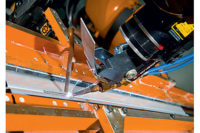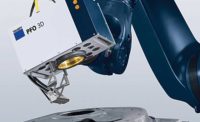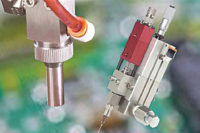The automobile industry’s use of lasers to build cars increases every year. In the 1970s, lasers began being used on underbodies. Since the 1980s, lasers have been used for gear parts and air-bag and engine components. About 20 years ago, lasers began to be used for brazing.
Laser brazing produces joints that are aesthetically pleasing. Initially, the brazing process was performed with fiber-coupled, lamp-pumped Nd: YAG lasers. Volkswagen, for example, used a 4-kilowatt YAG laser to braze zinc-coated steel roof joints on the Touran multipurpose vehicle at its Wolfsburg, Germany, plant.
But in 2001, the company began using diode lasers to braze the tailgate of its Audi model A3. Several years later, Volkswagen decided to try using diode lasers to braze the Touran roof joints. The company hoped to improve productivity without compromising joint quality. At the time, the YAG laser performed brazing at a speed of 2.4 meters per minute.
The company replaced the YAG laser with a 6-kilowatt LDF 6000-100 diode laser made by Laserline GmbH. The diode laser has a 3.2-millimeter-diameter beam focus, and a tactile brazing head with CuSi3 filler wire that optimizes the beam.
By using the diode laser, Volkswagen has increased its brazing speed to 4.4 meters per minute and reduced edge notches by 75 percent. The diode laser achieves this through its flat-top beam profile, which has smooth edges and provides better distribution of laser power into the joint.
As a result, Volkswagen replaced all YAG lasers on the Touran production line with LDF 6000-100 diode lasers. The company then did the same on its Touran production lines at plants in Jakarta, Indonesia, and Anting, China.
Next, Volkswagen looked to increase its use of diode lasers. In 2009, the company began using the Laserline LDF 4000-40 diode laser to weld visible aluminum surfaces on its Audi vehicles. To increase cost-effectiveness, Volkswagen uses the same type of welding equipment it uses for brazing, but adds AISi filler wire (using tactile seam tracking optics) to prevent hot cracking of the weld.
Volkswagen is very happy with the results. The diode laser generates a Class A weld on 1.2-millimeter-thick aluminum sheets that is smooth, visually appealing and requires no post-processing. Weld speed is 3 meters per minute. The reliability and cost advantages of using diode lasers has resulted in Volkswagen using them in many additional aluminum welding applications at Audi plants.
LDF diode lasers are available in fiber lengths of 10 meters to more than 100 meters, and they have a wavelength range of 900 to 1,070 nanometers. Their operational temperature is 10 to 45 C, and their storage temperature is 5 to 65 C.
The lasers offer 15,000 watts of power and have a footprint that’s less than 1 square meter. They can be easily moved to different locations whenever required and connected by a single person.
Besides brazing and welding aluminum, the lasers can be used for cladding and heat treatment.
For more information on diode lasers, call 408-834-4660 or visit www.laserline-inc.com.
German Automaker Discovers Dual Duty for Diode Lasers

After replacing its YAG laser with a diode laser, Volkswagen increased brazing speed of Touran roof joints to 4.4 meters per minute and reduced edge notches by 75 percent. Photo courtesy Laserline GmbH

In 2009, Volkswagen began using a diode laser to weld visible aluminum surfaces on its Audi vehicles. Photo courtesy Laserline GmbH
Looking for a reprint of this article?
From high-res PDFs to custom plaques, order your copy today!





